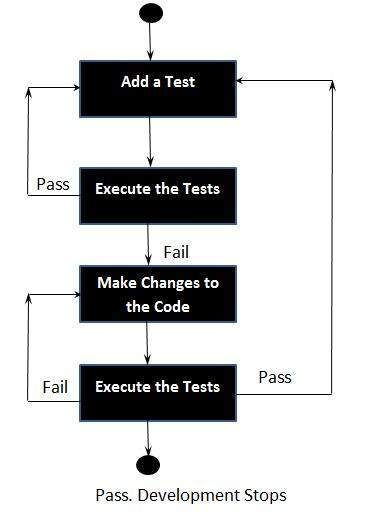What is Agile Methodology?
Agile methodology is the alternative of the traditional method of project management. The agile management is used in software development. This agile project management helps team to interact, responding unpredictably, which is called sprints. The agile methodologies are alternative to the waterfall methodology and traditional development.
Service-Oriented Architecture (SOA) Definition
http://www.service-architecture.com/articles/web-services/service-oriented_architecture_soa_definition.html
https://www.visualstudio.com/en-us/docs/test/developer-testing/getting-started/getting-started-with-developer-testing Test-driven development (TDD) is a software development process that relies on the repetition of a very short development cycle: requirements are turned into very specific test cases, then the software is improved to pass the new tests, only.
What is Test-Driven Development (TDD)?
Test-driven development starts with developing test for each one of the features. The test might fail as the tests are developed even before the development. Development team then develops and refactors the code to pass the test.
Test-driven development is related to the test-first programming evolved as part of extreme programming concepts.
Test-Driven Development Process:
-
Add a Test
-
Run all tests and see if the new one fails
-
Write some code
-
Run tests and Refactor code
-
Repeat
Add a Test
Run all tests and see if the new one fails
Write some code
Run tests and Refactor code
Repeat
Example:
Context of Testing:
-
Valid inputs
-
Invalid inputs
-
Errors, exceptions, and events
-
Boundary conditions
-
Everything that might break
Valid inputs
Invalid inputs
Errors, exceptions, and events
Boundary conditions
Everything that might break
Benefits of TDD:
-
Much less debug time
-
Code proven to meet requirements
-
Tests become Safety Net
-
Near zero defects
-
Shorter development cycles
Much less debug time
Code proven to meet requirements
Tests become Safety Net
Near zero defects
Shorter development cycles
Explaining 9 types of API testing. The method to download the high-resolution PDF is available at the end.
🔹 Smoke Testing
This is done after API development is complete. Simply validate if the APIs are working and nothing breaks.
🔹 Functional Testing
This creates a test plan based on the functional requirements and compares the results with the expected results.
🔹 Integration Testing
This test combines several API calls to perform end-to-end tests. The intra-service communications and data transmissions are tested.
🔹 Regression Testing
This test ensures that bug fixes or new features shouldn’t break the existing behaviors of APIs.
🔹 Load Testing
This tests applications’ performance by simulating different loads. Then we can calculate the capacity of the application.
🔹 Stress Testing
We deliberately create high loads to the APIs and test if the APIs are able to function normally.
🔹 Security Testing
This tests the APIs against all possible external threats.
🔹 UI Testing
This tests the UI interactions with the APIs to make sure the data can be displayed properly.
🔹 Fuzz Testing
This injects invalid or unexpected input data into the API and tries to crash the API. In this way, it identifies the API vulnerabilities.
Subscribe to our newsletter to download the 𝐡𝐢𝐠𝐡-𝐫𝐞𝐬𝐨𝐥𝐮𝐭𝐢𝐨𝐧 𝐜𝐡𝐞𝐚𝐭 𝐬𝐡𝐞𝐞𝐭. After signing up, find the download link on the success page: https://lnkd.in/egwCutXm
Explaining 9 types of API testing. The method to download the high-resolution PDF is available at the end.
🔹 Smoke Testing
This is done after API development is complete. Simply validate if the APIs are working and nothing breaks.
🔹 Functional Testing
This creates a test plan based on the functional requirements and compares the results with the expected results.
🔹 Integration Testing
This test combines several API calls to perform end-to-end tests. The intra-service communications and data transmissions are tested.
🔹 Regression Testing
This test ensures that bug fixes or new features shouldn’t break the existing behaviors of APIs.
🔹 Load Testing
This tests applications’ performance by simulating different loads. Then we can calculate the capacity of the application.
🔹 Stress Testing
We deliberately create high loads to the APIs and test if the APIs are able to function normally.
🔹 Security Testing
This tests the APIs against all possible external threats.
🔹 UI Testing
This tests the UI interactions with the APIs to make sure the data can be displayed properly.
🔹 Fuzz Testing
This injects invalid or unexpected input data into the API and tries to crash the API. In this way, it identifies the API vulnerabilities.
Subscribe to our newsletter to download the 𝐡𝐢𝐠𝐡-𝐫𝐞𝐬𝐨𝐥𝐮𝐭𝐢𝐨𝐧 𝐜𝐡𝐞𝐚𝐭 𝐬𝐡𝐞𝐞𝐭. After signing up, find the download link on the success page: https://lnkd.in/egwCutXm














No comments:
Post a Comment